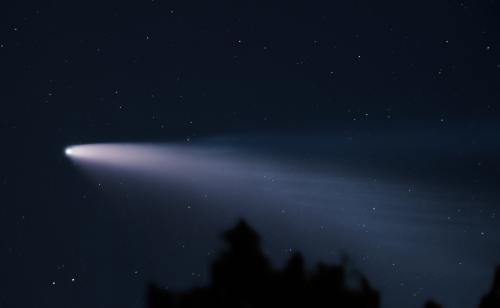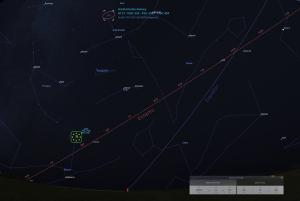Celebration of Space - September 27, 2024

Comet F3 NEOWISE, which became naked eye visible in summer 2020. Credit: Frosty Drew Astronomy Team member, Scott MacNeill, captured this image during on or our special events at Frosty Drew to view the comet.
Over the past week, Comet C/2023 A3 Tsuchinshan-ATLAS (Comet A3), has continued to brighten, and as of this morning (September 27, 2024), the comet is visible to the naked eye in the predawn sky. Of course, not for us in Southern New England, because the clouds have returned just in time. Regardless, the best views of the comet are still yet to come. Over the next two weeks, Comet A3 will be passing in between Earth and the Sun. Once this orbital motion is complete, the comet will become visible in the evening sky after sunset, and stunning views will kick back in on October 13, 2024. Some comet watchers have been predicting that over the next week or so the comet may become so bright that it will be visible to the naked eye in the daytime sky, but we aren’t betting on that just yet. In any case, the comet is set to put on quite a show in the evening sky this October. As of this morning’s forecast, Monday looks like we may have a clearing in the predawn sky to allow for a view of the comet. To catch a view, set out to a location with a very low view of the eastern horizon, and be there for 5:30 am. Comet A3 will be on the horizon at that time, but over the next 30 minutes the comet will rise to a position where it should be easily visible. This of course depends on how clear the sky is on the horizon. Let us know if you catch a view of the comet this weekend and/or coming week. Morning visibility will last until October 5th.
Now that autumn has officially arrived, prime viewing season for the Andromeda Galaxy is here. Residing in the constellation Andromeda, the galaxy will cross the zenith (top of the sky) in the hours up to midnight over the next two months, making for amazing views of our galactic neighbor.
The Andromeda Galaxy is the largest galaxy in the Local Group, which is the immediate group of galaxies that the Milky Way is part of. Residing at 2.5 million light years distant, the Andromeda Galaxy is the furthest object we can see with the naked eye at Frosty Drew. If you could see the Andromeda Galaxy fully with the naked eye, it would take up an area of the sky that is equal to the diameter of six full Moon’s. A wide field telescope will show the entire galaxy with spiral arms becoming visible. Binoculars are also a prime tool for observing the galaxy.
To catch a view, you will need to be at a location that is largely free of light pollution, and be there during a time that the Moon is below the horizon. Waiting until the galaxy is near the zenith will offer the best viewing. Here are two finder charts to aid in finding the galaxy:
The location of the Andromeda Galaxy
Starhop to the Andromeda Galaxy
Now make plans to visit Frosty Drew this autumn on a night without the Moon to catch a view of the Andromeda Galaxy!
Save the Date:
On Friday, October 25, 2024, Frosty Drew will host our annual Spooky Views – A Halloween Stargazing Experience. This event brings all the creeps of Halloween to the Frosty Drew campus. Even though it can get a bit spooky, the event is tailored for families with scavenger hunts, Story Time Under the Willow, telescopic observation of Saturn, Jupiter, and young white dwarf stars – the remnants of stars that have died, a presentation of the original War of the Worlds broadcast by Orson Wells, and loads of candy. It is certainly not a night to miss out on. Tickets will become available for the event in early October. So put the date on your calendar and gear up for a fantastic night of creepy sights, sounds, and fun at Frosty Drew Observatory and Science Center.
Even though it has been cloudy this week, the International Space Station (ISS), and China’s space station (Tiangong) have been rocking evening passes, and will continue to do so this weekend and early next week. Both stations will depart the night sky this coming week, though several notable passes are in store before they do. Here is a list of passes for the coming nights:
Tiangong:
Fri, Sep 27 at 7:40 pm, starting in the W, rising to 53º, heading towards the SE, and into orbital sunset
Sat, Sep 28 at 8:15 pm, starting in the W, rising to 23º, and into orbital sunset
Sun, Sep 29 at 7:13 pm, starting in the W, rising to 36º, heading towards the SE
Mon, Sep 30 at 7:49 pm, starting in the WSW, rising to 15º, heading towards the S
ISS:
Fri, Sep 27 at 8:13 pm, starting in the NW, rising to 74º, and into orbital sunset ← Awesome pass!
Sat, Sep 28 at 7:25 pm, starting in the NW, rising to 45º, heading towards the E, and into orbital sunset
Sun, Sep 29 at 8:13 pm, starting in the WNW, rising to 38º, and into orbital sunset
Mon, Sep 30 at 7:25 pm, starting in the WNW, rising to 69º, heading towards the SE, and into orbital sunset ← Awesome pass!
Tue, Oct 1 at 8:14 pm, starting in the W, rising to 14º, heading towards the SSW
Wed, Oct 2 at 7:25 pm, starting in the WNW, rising to 24º, heading towards the S
Put these times on your calendar, and set your alarms to catch sight of both stations passing over. For daily pass times of the stations and other bright satellites, check out the Frosty Drew Daily Satellite Pass Prediction Utility.
- Author:
- Scott MacNeill
- Entry Date:
- Sep 27, 2024
- Published Under:
- Scott MacNeill's Columns




